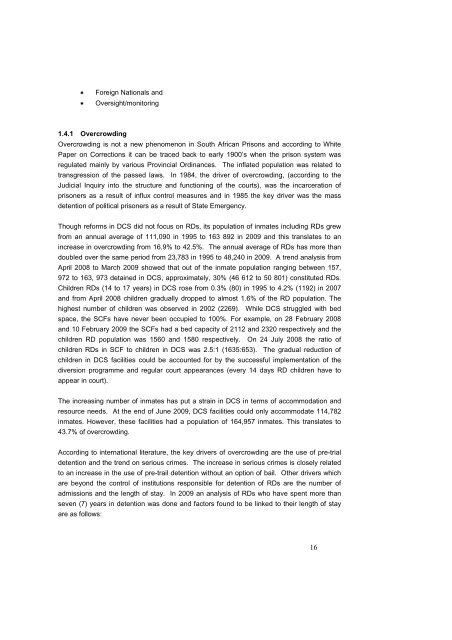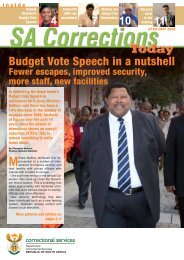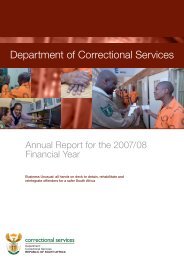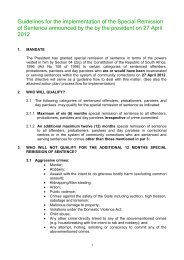Management of Remand Detainees in South Africa - DCS-Home
Management of Remand Detainees in South Africa - DCS-Home
Management of Remand Detainees in South Africa - DCS-Home
Create successful ePaper yourself
Turn your PDF publications into a flip-book with our unique Google optimized e-Paper software.
1.4.1 Overcrowd<strong>in</strong>g<br />
Foreign Nationals and<br />
Oversight/monitor<strong>in</strong>g<br />
Overcrowd<strong>in</strong>g is not a new phenomenon <strong>in</strong> <strong>South</strong> <strong>Africa</strong>n Prisons and accord<strong>in</strong>g to White<br />
Paper on Corrections it can be traced back to early 1900’s when the prison system was<br />
regulated ma<strong>in</strong>ly by various Prov<strong>in</strong>cial Ord<strong>in</strong>ances. The <strong>in</strong>flated population was related to<br />
transgression <strong>of</strong> the passed laws. In 1984, the driver <strong>of</strong> overcrowd<strong>in</strong>g, (accord<strong>in</strong>g to the<br />
Judicial Inquiry <strong>in</strong>to the structure and function<strong>in</strong>g <strong>of</strong> the courts), was the <strong>in</strong>carceration <strong>of</strong><br />
prisoners as a result <strong>of</strong> <strong>in</strong>flux control measures and <strong>in</strong> 1985 the key driver was the mass<br />
detention <strong>of</strong> political prisoners as a result <strong>of</strong> State Emergency.<br />
Though reforms <strong>in</strong> <strong>DCS</strong> did not focus on RDs, its population <strong>of</strong> <strong>in</strong>mates <strong>in</strong>clud<strong>in</strong>g RDs grew<br />
from an annual average <strong>of</strong> 111,090 <strong>in</strong> 1995 to 163 892 <strong>in</strong> 2009 and this translates to an<br />
<strong>in</strong>crease <strong>in</strong> overcrowd<strong>in</strong>g from 16.9% to 42.5%. The annual average <strong>of</strong> RDs has more than<br />
doubled over the same period from 23,783 <strong>in</strong> 1995 to 48,240 <strong>in</strong> 2009. A trend analysis from<br />
April 2008 to March 2009 showed that out <strong>of</strong> the <strong>in</strong>mate population rang<strong>in</strong>g between 157,<br />
972 to 163, 973 deta<strong>in</strong>ed <strong>in</strong> <strong>DCS</strong>, approximately, 30% (46 612 to 50 801) constituted RDs.<br />
Children RDs (14 to 17 years) <strong>in</strong> <strong>DCS</strong> rose from 0.3% (80) <strong>in</strong> 1995 to 4.2% (1192) <strong>in</strong> 2007<br />
and from April 2008 children gradually dropped to almost 1.6% <strong>of</strong> the RD population. The<br />
highest number <strong>of</strong> children was observed <strong>in</strong> 2002 (2269). While <strong>DCS</strong> struggled with bed<br />
space, the SCFs have never been occupied to 100%. For example, on 28 February 2008<br />
and 10 February 2009 the SCFs had a bed capacity <strong>of</strong> 2112 and 2320 respectively and the<br />
children RD population was 1560 and 1580 respectively. On 24 July 2008 the ratio <strong>of</strong><br />
children RDs <strong>in</strong> SCF to children <strong>in</strong> <strong>DCS</strong> was 2.5:1 (1635:653). The gradual reduction <strong>of</strong><br />
children <strong>in</strong> <strong>DCS</strong> facilities could be accounted for by the successful implementation <strong>of</strong> the<br />
diversion programme and regular court appearances (every 14 days RD children have to<br />
appear <strong>in</strong> court).<br />
The <strong>in</strong>creas<strong>in</strong>g number <strong>of</strong> <strong>in</strong>mates has put a stra<strong>in</strong> <strong>in</strong> <strong>DCS</strong> <strong>in</strong> terms <strong>of</strong> accommodation and<br />
resource needs. At the end <strong>of</strong> June 2009, <strong>DCS</strong> facilities could only accommodate 114,782<br />
<strong>in</strong>mates. However, these facilities had a population <strong>of</strong> 164,957 <strong>in</strong>mates. This translates to<br />
43.7% <strong>of</strong> overcrowd<strong>in</strong>g.<br />
Accord<strong>in</strong>g to <strong>in</strong>ternational literature, the key drivers <strong>of</strong> overcrowd<strong>in</strong>g are the use <strong>of</strong> pre-trial<br />
detention and the trend on serious crimes. The <strong>in</strong>crease <strong>in</strong> serious crimes is closely related<br />
to an <strong>in</strong>crease <strong>in</strong> the use <strong>of</strong> pre-trail detention without an option <strong>of</strong> bail. Other drivers which<br />
are beyond the control <strong>of</strong> <strong>in</strong>stitutions responsible for detention <strong>of</strong> RDs are the number <strong>of</strong><br />
admissions and the length <strong>of</strong> stay. In 2009 an analysis <strong>of</strong> RDs who have spent more than<br />
seven (7) years <strong>in</strong> detention was done and factors found to be l<strong>in</strong>ked to their length <strong>of</strong> stay<br />
are as follows:<br />
16













